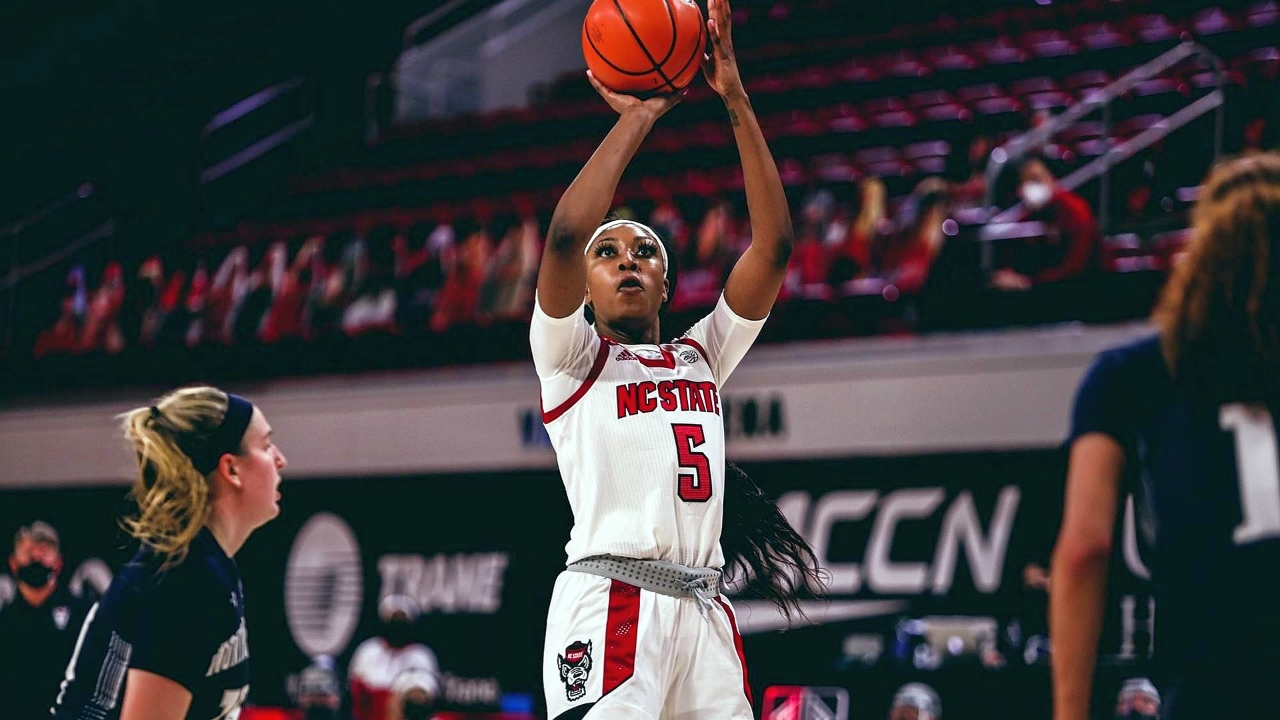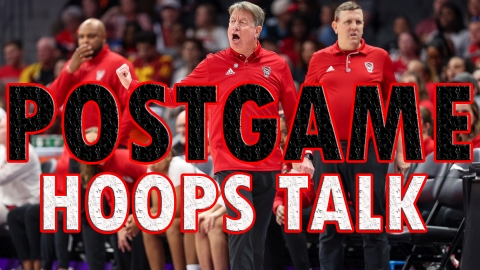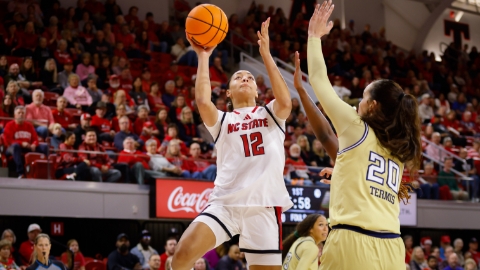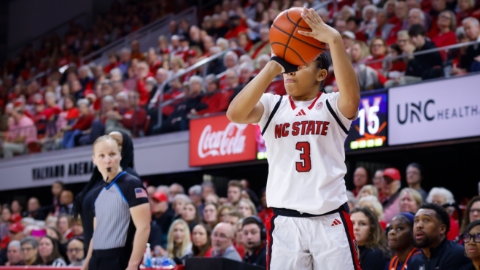
On the heels of losses by two top-five teams, the NC State women’s basketball team has risen to No. 2 in the AP Top 25. The Wolfpack has looked the part of one of the best teams in the country for nearly the entire season.
But what has been the driving force behind the Pack’s success (and failures)? Let’s take an analytical look.
Rotation
It’s no secret that head coach Wes Moore doesn’t like to go deep into his bench during important games. Only six players are averaging more than 19 minutes per game, with a seventh player, sophomore center Camille Hobby, averaging 17.6 minutes per game since NC State’s return from a three-week COVID-19 shutdown.
So what has been the best five-woman combination for Moore and the Wolfpack? Well, it’s one with sophomore forward Jada Boyd, the Pack’s sixth woman. The lineup of senior guard Kai Crutchfield, sophomore forward Jakia Brown-Turner, senior forward Kayla Jones, Boyd, and junior center Elissa Cunane has been far and away NC State’s best combination.
That group has an 81.9 net rating (meaning it outscores opponents by 81.9 points per 100 possessions), in the 99th percentile of the entire NCAA. It’s the group’s offensive prowess that makes it such a devastating combination for opponents. With those five on the floor, NC State is scoring 158.3 points per 100 possessions; in layman’s terms, the Wolfpack is scoring more than a point and a half each trip down the court. That also resides in the 99th percentile.
Curiously, that group doesn’t see the floor all too often. Although those five have only been healthy and active together in 71% of NC State’s games, it’s still only Moore’s fifth-favorite lineup combination.
Moore’s favorite group, his starting five of Crutchfield, Brown-Turner, Jones, Cunane, and graduate guard Raina Perez, is still among the country’s best. That group boasts a 36.7 net rating and is far and away the lineup Moore uses the most. But what drags it down to the 85th percentile in the NCAA is its defense. With an 82 defensive rating that lands in the 70th percentile, the starting five’s defense has taken a noticeable step back from last season, when the Pack’s defense was in the 84th percentile.
The usage of Hobby has been less than fruitful. Although her raw totals have been solid (19 points against Virginia Tech, 12 points against Clemson), the team seems to suffer when she’s on the court. Hobby is on the floor in two of NC State’s four most-used lineups, but the Pack’s net rating sits at just 17.7 in one and all the way down to -21.4 in the other.
Although Hobby is going to have to provide some minutes in the postseason, it might serve Wes Moore better to give more of her minutes to Jada Boyd. In the two most-used lineups with Boyd on the court, NC State is outscoring opponents by 32.8 points per 100 possessions (most-used) and 81.9 points per 100 possessions (second most-used).
Shooting
It’s been obvious that NC State has been a streaky 3-point shooting team this season, shooting above 40% from deep as many times (seven) as it has shot below 30%. However, one area the Wolfpack hasn’t been streaky is shooting corner threes.
NC State is shooting 50% from the left corner and 54% from the right corner, good for 18% and 22% above league average, respectively. The issue, though, is that the Wolfpack isn’t taking enough shots from there. Just 6.1% of NC State’s shot attempts come from the corners, as the Wolfpack instead likes to settle for wing and top-of-the-key looks, which constitute 25.4% of its attempts and where the Pack hovers around league average.
Jakia Brown-Turner has been the biggest reason for NC State’s corner-3 efficiency. The former McDonald’s All-American has blossomed into a star this year, and her 67% shooting percentage on corner threes is a huge reason why. Brown-Turner is shooting 85.7% from the left corner and 54.5% from the right corner,
Although it could sacrifice some left-wing 3-pointers (connecting on a below-average 30.7% clip) for more corner threes, NC State’s shot selection has been excellent. The Wolfpack has almost entirely foregone mid-range jumpers, the most inefficient shot in basketball; 63% of NC State’s shot attempts come from the 3-point line or at the rim, with an additional 23.1% from inside the paint. That means only 13.7% of the Pack’s shots are inefficient mid-range jumpers.
This smart, analytically-sound shot selection is one of the leading reasons as to why the Wolfpack’s 56.2% true shooting percentage and 53.2% effective field-goal percentage both sit in the 95th percentile. However, even though it isn’t Wes Moore’s style, shooting more threes could increase those efficiency rates even more.
Although NC State’s 36.3% clip from deep is in the 90th percentile in the country, the Pack is only taking 31.5% of its shots from beyond the arc, which is a well below-average rate. If NC State were to increase its share of 3-point attempts to league average, the Wolfpack could see heightened efficiency numbers.
Even Brown-Turner, who is among the best in the country at making corner threes, isn’t shooting from the corners enough. Despite her prolific percentages, she’s taking only 8% of her shots and 23% of her threes from the corners.
Rebounding
NC State is out-rebounding teams by nearly 10 boards per game, and it’s the Wolfpack’s consistent limiting of second-chance opportunities for opponents -- and creation of second-chance opportunities for itself -- that has led to such a big advantage down low.
The Pack’s most-used lineup, its starting five, is corralling 76% of its opponents’ missed shots, and its post players are a huge reason why. Boyd, Cunane, and Jones all have defensive rebounding percentages in the 86th percentile or higher. When they’re each on the court, Boyd is hauling in 24.3% of available defensive rebounds, Cunane is nabbing 20.4%, and Jones brings down 18.7%.
It’s the same story on offense, too, where Cunane’s 10.1% offensive rebounding percentage falls in the 86th percentile and Jones’ 6.7% rate is in the upper third at 67%. Those two are powering a Wolfpack squad that is corralling 32.3% of its offensive rebounds.
Free Throws
If there is one area where NC State has consistently and glaringly struggled, it’s getting to the free-throw line. Despite attempting 54.6% of its shots from inside the paint or at the rim, the Wolfpack’s free-throw attempt rate sits at just 25.8%. This lies in the bottom third of the NCAA and the bottom five of the ACC.
The primary culprits of this are the Wolfpack’s guards. Perez, Crutchfield, and Brown-Turner struggle mightily at getting to the free-throw line. All three of them have sub-20% free-throw rates, something that could point toward a big step forward in shooting efficiency if they were to improve upon that.
It’s got a lot to do with the fact that those three all take a below-average percentage of their shots from inside the paint, where the vast majority of shooting fouls occur. Brown-Turner leads the trio with 48.7% of her shots from inside the paint or at the rim, while Perez and Crutchfield trail behind with 43.9% and 27.6%, respectively.
That group is comprised of excellent free-throw shooters, as they’re knocking down a combined 77% of their shots from the charity stripe. If they were to keep that same efficiency while adding a few more trips to the line per game, it would be a boon to NC State’s overall efficiency.
Defense
Although Wes Moore is known for his adoration of, and focus on, hard-nosed, gritty defense, this iteration of the Wolfpack hasn’t been among the game’s best defensive teams.
A large part of that is that forcing steals and blocking shots has been at a premium for NC State while on defense. The Pack’s “Hakeem percentage,” the sum of a team’s block percentage and steal percentage (named after NBA Hall of Famer Hakeem Olajuwon), is below average at 18.4%.
NC State is blocking shots reasonably well, with an 8.9% block percentage, meaning the Wolfpack is blocking 8.9% of opponents’ two-point shot attempts. Hobby and Cunane are a big part of that, with a 4.5% and 4.1% block percentage, respectively; both are in the 88th percentile or better.
Now, this isn’t to say the defense has been bad; it hasn’t. It’s been pretty good, actually. NC State is doing an excellent job of forcing teams into ill-advised shots; the Wolfpack has held teams to a 41.4% effective field-goal percentage, an 87.4 offensive rating, and is limiting teams to taking just 37.6% of their shots from deep.
However, it’s the lack of steals that is limiting NC State’s defensive upside. The Pack is nabbing a steal on less than 10% of its opponents’ possessions, which sits dysmally in the 29th percentile and is well below average.
Four of the five teams ranked ahead of NC State in the NCAA Selection Committee’s official NCAA Tournament seeding rankings are all ahead of the Wolfpack defensively. The lone team ahead of NC State in the AP Top 25, UConn, sits 71 spots ahead of the Pack. If NC State wants to win a national championship, it’s likely going to need to play elite defense -- not just pretty good defense.
Ball Control
NC State has excelled at protecting the ball and limiting turnovers. Perez, Jones, and Cunane all sit in the 81st percentile or better in turnover percentage, and Perez’s 2.7 assist-to-turnover ratio ranks first in the ACC.
Perez, as the point guard, and Jones, as a type of point forward, have been particularly exceptional at running the offense. Perez tends to run the offense from the perimeter, while Jones operates from the low block, and it has led to Perez assisting on 25.7% of shots and Jones on 17%.
The Wolfpack as a whole has been generous when it comes to sharing the ball, assisting on 54% of its made shots while turning the ball over on just 15.6% of its possessions. That turnover percentage is a marked improvement over the last two seasons when the Pack turned the ball over on over 17% of its possessions.
Even Cunane, not typically asked to do much sharing of the ball once she has it down low, has a career-high 10.3% assist rate and has dished out seven dimes in her last two games. Likewise, a big part of Brown-Turner’s sophomore-year leap has been her increased playmaking ability (11.4% assist rate in 2019-20 to 14.3% in 2020-21) and significantly cutting down on her turnovers (15.4% turnover rate in 2019-20 to a team-low 9.7% in 2020-21).
Elissa Cunane
With the emergence of Jones and Brown-Turner as borderline star players, Elissa Cunane has somehow managed to fly a little under the radar this year. That shouldn’t be the case, though. Despite a slight decrease in raw averages, Cunane has been hands-down the Wolfpack’s best player this year and is still one of the handful of best players in the entire country.
Cunane boasts a net rating that sits in the 99th percentile; when she’s on the court, NC State is outscoring opponents by 40 points per 100 possessions. When she’s on the court, NC State is scoring over 118 points per 100 possessions, also in the 99th percentile. Lastly, when she’s on the court, NC State is holding teams to just 78.7 points per 100 possessions, “only” in the 95th percentile.
In addition to net rating, offensive rating, and defensive rating, the 6-foot-5 center leads the team in turnover percentage, offensive rebounding percentage, opponent effective field-goal percentage, and opponent free-throw rate.
It’s not just her advanced stats, either. She’s shooting a career-high 45% from the 3-point line on a career-high 1.3 attempts per game, is averaging a career-low 1.9 turnovers per game, and is dishing out a career-high 1.4 assists per game.
Cunane’s shooting efficiency has been masterful. She’s taking over 65% of her shots from the two most efficient locations on the court: at the rim and from beyond the arc. 80% of her shots come inside the paint or at the rim, and she’s converting those at a 60% clip.
She knows where and when to take her shots from deep, too; she’s shooting 50% on top-of-the-key and left-wing 3s, and she’s attempting 70% of her treys from those locations.



